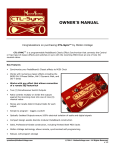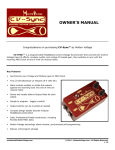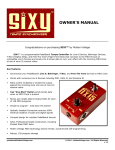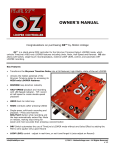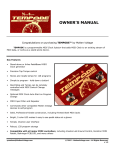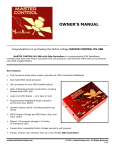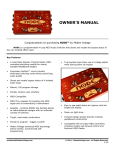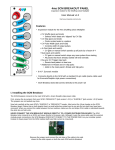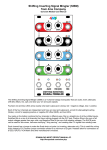Download MIDI Delaytion Owner`s Manual
Transcript
OWNER’S MANUAL Congratulations on purchasing MIDI Delaytion™, the Analog Delay Control Station by Molten Voltage MIDI Delaytion is a programmable Analog Delay Controller, designed to control the MXR Carbon Copy, Malekko Ekko 616, and any other delay that uses the classic Bucket Brigade Delay (BBD) analog chips. Note: your analog delay must be modified to accept MIDI Delaytion’s clock signal. You can buy pre-modified delays from Molten Voltage, or send in yours for modification. See MoltenVoltage.com for more information. Key Features • MIDI Clock Synchronization ~ or ~ Manual Delay Time Control • Automatically scales the delay time to stay in sync with slower MIDI Clock tempos. • 3 Delay Ratios (dotted eighth, quarter note, and triplets) • Modulation Rate and Depth controls • Program up to 128 Presets! • Simple to program - just toggle a switch! • Expanded Modulation Rate and Depth • Solid, Professional-Grade construction • Simple, intuitive user interface [email protected] © 2014 - MoltenVoltage.com - All Rights Reserved. v 1.0 Molten Voltage™ MIDI Delaytion™ Owner’s Manual - p.2 Connections Plug in a 9 volt, 2.1mm, 100mA minimum, tip negative DC Power supply into the DC9V Power Jack (C). (A) MIDI THRU Jack (B) CLOCK OUT Jack (C) DC Power Jack (D) MIDI IN Jack (E) Status LED (F) Delay Tempo LED (G) MIDI/Pot Select LED (H) PGM Switch (I) Delay Ratio Switch (J) MIDI/Pot Select Switch (K) RATE Knob (L) DEPTH Knob (M) DELAY Knob Connect a standard RCA cable to the CLOCK OUT Jack (B). Connect the other end to the Modified Analog Delay. [email protected] © 2014 - MoltenVoltage.com - All Rights Reserved. v 1.0 Molten Voltage™ MIDI Delaytion™ Owner’s Manual - p.3 MIDI Output Connect a standard 5-pin MIDI cable from the MIDI THRU Jack (A) to the MIDI IN Jack on your compatible device. Note: The MIDI Thru jack repeats all MIDI messages received at the input, irrespective of MIDI Channel. MIDI Input Connect a standard 5-pin MIDI cable from the device sending MIDI Program Changes to the MIDI IN Jack (D) on MIDI Delaytion. When a Program Change is received on the correct MIDI Channel, MIDI Delaytion changes to the new preset. Operation MIDI Delaytion reads the Rate, Depth, and Delay input pots, MIDI/Pot Switch, and Ratio Select switches on startup, and sets the output accordingly. MIDI/Pot Selection MIDI Delaytion can be synchronized to an incoming MIDI Clock. In the alternative, the delay time can be set manually using the DELAY Knob (M). Use the MIDI/Pot Select Switch (J) to select MIDI or Pot delay time control. The “up” position corresponds to MIDI, while “down” means Pot. Note: The MIDI/Pot Selection is stored as part of each program. As such, when you recall a program, the LED will indicate whether you are in MIDI or Pot mode. Note that the MIDI/Pot Select Switch may not be in the same position as the LED indicates. To switch to Pot when the switch is already down but the LED is yellow, move the switch up, then down again. When MIDI Clock is present, and the MIDI/Pot selection is MIDI, MIDI Delaytion synchronizes the delay time to that clock (and as adjusted by the Delay Ratio Switch). [email protected] © 2014 - MoltenVoltage.com - All Rights Reserved. v 1.0 Molten Voltage™ MIDI Delaytion™ Owner’s Manual - p.4 Delay Time Controls DELAY Knob MIDI Delaytion’s delay time can be set manually by adjusting the DELAY Knob (M). This range can be further adjusted using the Delay Ratio Switch (I), discussed below. Note: The MIDI/Pot Selection must be set to “Pot” (Yellow LED off). Delay Tempo LED The Red Delay Tempo LED (F) always flashes in time with the current delay time, as adjusted by the Delay Time Ratio switch. Delay Ratio Switch Use the Delay Ratio Switch (I) to select between three different delay ratios: Following are the ratios: Left = dotted eighth (75% of delay time) Center = quarter note (100% of delay time) Right = eighth note triplet (33% of delay time) Note: The Delay Ratio Switch affects both MIDI Clock and DELAY Knob-based delay times. Modulation Controls MIDI Delaytion can modulate the delayed signal, making it faster then slower in a virtual sine-wave pattern. Turn the RATE Knob (K) to control the speed of the modulation. The RATE Knob adjusts the modulation rate between 0.0625 and 5.0 seconds. Turn the DEPTH Knob (L) to control how far up and down the signal is detuned. The DEPTH Knob adjusts depth of the modulation waveform between zero and 50% of the current delay time. Note: The modulation depth is limited by the Delay Time Max. As such, at the minimum and maximum delay times, no modulation will occur. As you move away from those limits, the available modulation depth increases. At very slow modulation rates, you may hear some “stepping”. If so, increase the depth or modulation rate. [email protected] © 2014 - MoltenVoltage.com - All Rights Reserved. v 1.0 Molten Voltage™ MIDI Delaytion™ Owner’s Manual - p.5 Program Storage MIDI Delaytion is designed to make switching and storing programs as simple as possible so you can concentrate on being creative. Once you have MIDI Delaytion set the way you like, simply toggle the PGM Switch (H) down then up, and the program is stored at the current program location. Note: Programs can also be stored upon a self-programming command from the Molten Voltage MASTER CONTROL or Molten Voltage TEMPODE (PedalBoard MIDI Clock Injector). MIDI Delaytion stores the modulation rate and depth, as well as the delay time and current delay ratio. This means that when a program is recalled, the knobs and switches will usually be in different positions than what is actually being used by the controller. Note: Programs remain in MIDI Delaytion’s memory after the power is removed. The Status LED (E) is normally on. When a program is written, the Status LED will flash to indicate success. Whenever the knobs have recently moved, the Status LED will turn off until they become stable again. Each knob will stabilize after approximately three (3) seconds without motion. Program Recall MIDI Delaytion stores the Modulation Rate, Modulation Depth, Delay Speed, and Delay Time Ratio associated with each of 128 Programs. Programs are recalled upon receipt of MIDI Program Change messages on the correct MIDI Channel. If MIDI Clock is being sent, any new clock speed is used immediately. Note: MIDI Delaytion responds to discrete Program Change messages, as well as those sent using the “running status” data format. Selecting MIDI Channel and Jitter Compensation Level MIDI Delaytion offers 3 levels of jitter compensation and can be set to respond to MIDI Program Change messages on MIDI Channel 1 or 15. Note: MIDI Clock is not channel-specific. As such MIDI Delaytion will always respond to an incoming MIDI Clock if the MIDI/Pot Selection is “MIDI”. Many sources of MIDI Clock are “jittery”, meaning the clock’s timing jumps around slightly. To compensate for MIDI Clock jitter, MIDI Delaytion can be set to either Small or Large jitter compensation as needed. Let your ears be the guide. Note: Molten Voltage’s TEMPODE and MASTER CONTROL are not “jittery” so no jitter compensation is necessary. [email protected] © 2014 - MoltenVoltage.com - All Rights Reserved. v 1.0 Molten Voltage™ MIDI Delaytion™ Owner’s Manual - p.6 To change the MIDI Channel and Jitter Compensation Level, have the PGM Switch (H) in the “up” position when powering on. Switch the PGM Switch down within 2 seconds. The Status LED (E) will blink in a pattern, indicating the current Output Mode and MIDI Channel. Output Mode No Jitter Compensation No Jitter (DEFAULT) Small Jitter Compensation Small Jitter Compensation Large Jitter Compensation Large Jitter Compensation MIDI Channel 1 15 1 15 1 15 LED Blinking Pattern LED off with 1 pulse on LED on with 1 pulse off LED off with 2 pulses on LED on with 2 pulses off LED off with 3 pulses on LED on with 3 pulses off Turn the RATE Control (K) to select between the 3 Jitter Compensation Levels: Full Left = No Jitter Compensation Center = Small Jitter Compensation Full Right = Large Jitter Compensation Turn the DEPTH Control (L) to select between MIDI Channel 1 and 15. Full Left = MIDI Channel 1 Full Right = MIDI Channel 15 Switch the PGM switch back up to store the Output Mode and MIDI Channel. Note: Changing Output Mode and MIDI Channel does not overwrite any stored programs. Factory Preset Values • 1:1 (Quarter Note) Ratio • MIDI Channel 15 Note: the primary MIDI channel for the Molten Voltage system is MIDI Channel 15, but Program Change messages on that channel are re-transmitted on Channel 1 which is the common Line 6 MIDI Channel. MIDI Phantom Power MIDI Delaytion does not use MIDI Phantom Power. [email protected] © 2014 - MoltenVoltage.com - All Rights Reserved. v 1.0 Molten Voltage™ MIDI Delaytion™ Owner’s Manual - p.7 MIDI IMPLEMENTATION CHART Function Note On Note Off Aftertouch Control Change Program Change Passed O O O O O Accepted X X X X O Channel Pressure Pitch Bend System Common System Exclusive O O O O X X X O System Realtime O O Comment Program Change data must be on the same MIDI Channel as MIDI Delaytion. MIDI Delaytion responds to Molten Voltage selfprogram commands. Only MIDI Start, Stop, and Clock. O = YES, X = NO TROUBLESHOOTING Problem MIDI Delaytion will not turn on. Solution Plug in 9 volt DC, 2,1mm Tip Negative Power Supply that can supply at least 100mA of current. Clicking or Noise Use a separate or isolated Power Supply for MIDI Delaytion MIDI Delaytion is not receiving MIDI Clock Make sure your other MIDI device is configured to send MIDI Clock. Consult the User’s Guide for that device. If it cannot send MIDI Clock, consider the Molten Voltage devices MASTER CONTROL or TEMPODE. MIDI Delaytion not receiving MIDI Program Change messages Set your MIDI device to send MIDI Program Change messages on MIDI Channel 1 or 15. Delay sounds “glitchy” when synchronized to MIDI Clock Adjust the Jitter Compensation Level as described above. Analog Delay is not synchronized Make sure the Analog Delay is attached to MIDI Delaytion using a standard RCA cable. General Guidelines Keep MIDI cables as short as possible. Long cables cause errors. If you need more length, consider using a MIDI repeater. If you are daisy chaining MIDI devices, the total MIDI cable length must be considered if any MIDI devices do not amplify the data signal. [email protected] © 2014 - MoltenVoltage.com - All Rights Reserved. v 1.0 Molten Voltage™ MIDI Delaytion™ Owner’s Manual - p.8 Related Products • Molten Voltage MASTER CONTROL (MV-58 and MV-58B) • Molten Voltage TEMPODE, the MIDI Clock Injector • Molten Voltage MIDI Splitty - MIDI PedalBoard Splitter / Repeater Many more available soon! Support [email protected] Warranty Molten Voltage is proud of its products and warrants this unit for a period of two (2) years from the date of purchase to be free from defects in materials and workmanship under normal use and service, as long as the unit is used with an approved power supply, and consistent with these instructions. Contact [email protected] regarding repairs. Any user repair attempts void the warranty. PROOF OF PURCHASE IS REQUIRED FOR WARRANTY REPAIRS. DISCLAIMER Information contained in this publication regarding device applications and the like is provided only for your convenience and may be superseded by updates. It is your responsibility to ensure that your application meets with your specifications. MOLTEN VOLTAGE MAKES NO REPRESENTATIONS OR WARRANTIES OF ANY KIND WHETHER EXPRESS OR IMPLIED, WRITTEN OR ORAL, STATUTORY OR OTHERWISE, RELATED TO THE INFORMATION, INCLUDING BUT NOT LIMITED TO ITS CONDITION, QUALITY, PERFORMANCE, MERCHANTABILITY OR FITNESS FOR PURPOSE. Molten Voltage disclaims all liability arising from this information and its use. No licenses are conveyed, implicitly or otherwise, under any Molten Voltage intellectual property rights. Carbon Copy is a trademark of Dunlop Manufacturing Inc., and Ekko 616 is a trademark of Malekko Heavy Industry, none of which are related to Molten Voltage. MIDI Delaytion, Tru-Foot, ReMute, NODE, Molten Voltage, Visionary Effects, DIGITAL CONTROL : ANALOG SIGNAL, "Design simple Design sublime", and "the future just showed up" are all trademarks of Molten Voltage. [email protected] [email protected] © 2014 - MoltenVoltage.com - All Rights Reserved. v 1.0








